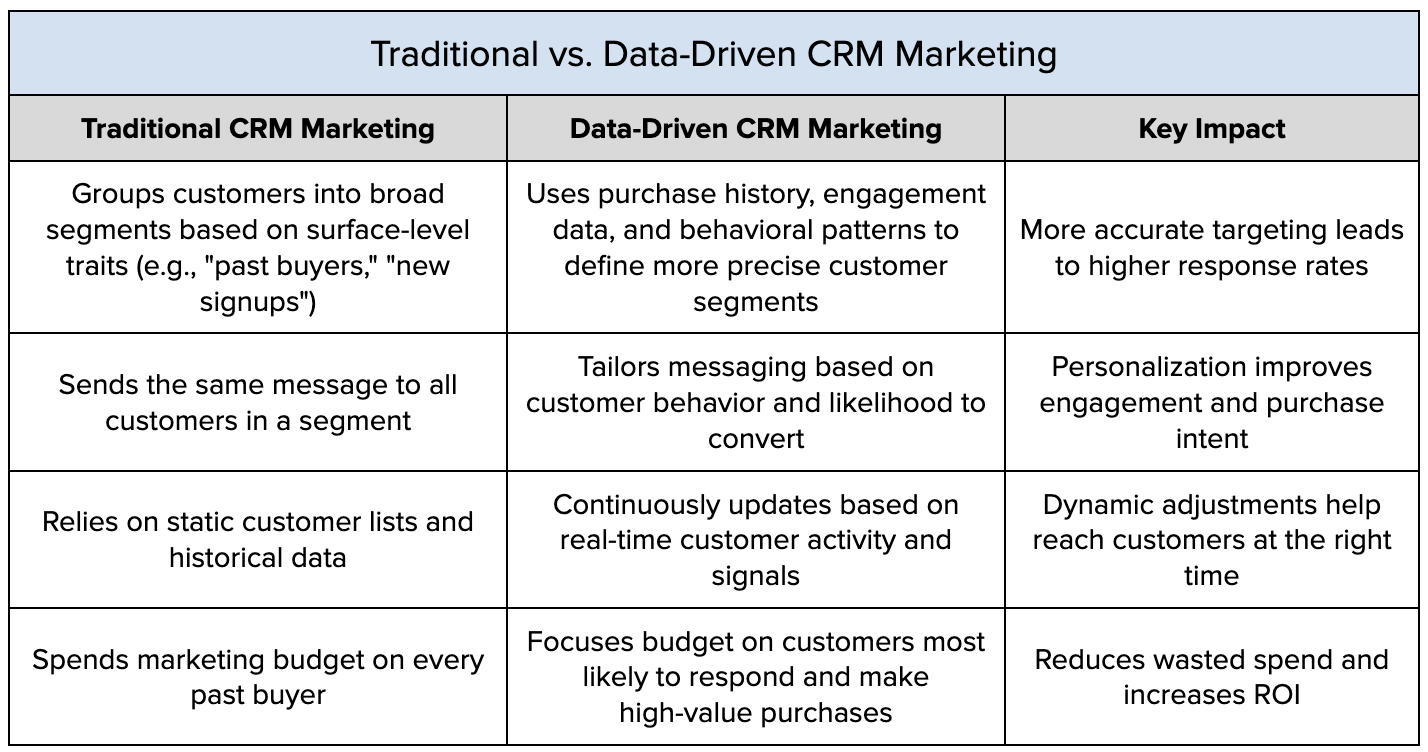You have tons of prospects and customers in your CRM… What are you doing with them? If you’re treating them all the same, you’re missing out on the real power of that data.
Your CRM has the best data—what people buy, how they interact with your brand, and when they’re most likely to take action—to make marketing more personal and effective. By using this data appropriately, you can match messaging to individual customer needs, reaching the right person with the right message at the right time.
We all know how this works. Instead of blasting the same email to all customers, CRMs can track each person’s behavior. If a customer recently bought running shoes, the brand might send them a follow-up email with recommendations for running socks or a smartwatch. If another customer browsed winter jackets but doesn’t buy, they might get a limited-time discount offer. By tailoring messages based on real actions, the brand increases the chances of engagement and sales.
A generic coupon for an irrelevant product has little impact, but a well-timed offer on something a customer was already considering feels useful. CRM marketing helps customers feel seen, understood, and engaged—which leads to better business outcomes. Let’s get into how CRM marketing helps businesses turn customer data into stronger relationships and higher sales.
How to Make CRM Marketing Smarter by Understanding the Data
Marketing teams spend years building customer databases, but having a long list of contacts doesn’t guarantee results. Without the right strategy, even the most extensive CRM can turn into a cluttered repository of outdated information. Without deeper insights into customer behavior, these efforts fall flat, missing the opportunity to connect on a personal level.
This shift from broad, one-size-fits-all messaging to precise, data-driven targeting is what separates high-performing CRM strategies from wasted marketing spend.
Why Traditional CRM Marketing Misses the Mark
Most CRM marketing strategies still rely on broad segmentation—grouping customers into large, loosely defined categories based on surface-level traits. Maybe it’s “past buyers,” “loyal customers,” or “new signups.” While this approach is better than blind mass marketing, it fails to account for individual purchasing behavior and intent.
A common approach in CRM marketing is to send a generic discount to every past customer, assuming it will encourage repeat purchases. It’s a method that leads to the following inefficiencies:
- Lost revenue: Some customers were already planning to buy, so offering a discount unnecessarily reduces profit margins.
- Wasted marketing spend: Others are unlikely to respond at all, meaning advertising dollars are spent with no return.
- Low impact: Only a small percentage of recipients are genuinely influenced by the campaign, making broad segmentation an inefficient strategy.
What traditional CRM marketing lacks is precision—the ability to target the right customers at the right time with the right offer. Instead of broad, outdated segmentation, today’s best CRM strategies use data-driven insights to create high-impact, hyper-relevant campaigns that drive stronger results.

How Data-Driven Insights Improve Customer Targeting
Data-driven CRM strategies go beyond better segmentation. The real advantage comes from knowing how to actually use your first-party data, which provides the most accurate picture of who your customers are, what they buy, and when they’re ready to engage.
Many brands assume CRM success depends on having years of historical customer interactions—whether through email campaigns, direct mail, or other touchpoints. But that’s not the case. Even businesses with limited customer outreach can improve results by leveraging their first-party data in the right way, including purchase history, website activity, and engagement patterns.
First party data benefits include:
- Source of truth: First-party data is real, reliable, and customer-specific since it comes directly from interactions with your business.
- Behavior-based insights: It reflects actual purchasing and engagement behaviors, such as which customers buy high-ticket items and who abandons carts.
- Long-term value: As privacy regulations limit third-party tracking, first-party data remains a sustainable and future-proof resource for precise customer targeting.
With the right data insights, businesses can:
- Target customers based on real intent, not broad assumptions
- Reduce wasted ad spend by focusing on the highest-value prospects
- Improve response rates by aligning offers with actual customer behavior
Smart CRM marketing isn’t about blasting messages to an entire list. It’s about leveraging first-party data to identify intent, reduce wasted spend, and align messaging with actual customer behavior. That shift leads to more meaningful interactions and, ultimately, stronger sales.
Turn Customer Data into Revenue, Not Reports
Businesses are sitting on a goldmine of customer data, but raw information alone doesn’t drive sales. CRM marketing isn’t just about sending offers to past buyers—it’s about identifying high-value customers and predicting when they’re most likely to purchase. When CRM strategies are optimized, the impact is measurable: higher engagement, increased purchase frequency, and greater spend per transaction.
Companies that pinpoint high-value customers see stronger ROI and revenue growth compared to those relying on broad segmentation. Postie can do just that with our CRM Optimization engine. Instead of treating every customer the same, CRM Optimization pinpoints who is most likely to make high-value purchases, ensuring marketing dollars are spent on the right audience. This shift from low-value, frequent buyers to high-AOV purchasers creates a measurable increase in revenue per transaction.
Case Study: How Premium Purchasers can Drive Higher Sales
A premium outdoor brand struggled to increase revenue from repeat customers. Their loyal base frequently purchased low-cost items, such as drinkware, but weren’t upgrading to high-ticket products like coolers and travel gear. Despite a strong marketing strategy, their average order value (AOV) remained low, limiting overall growth.
Using CRM Optimization, the brand refined its targeting strategy—not just focusing on repeat buyers, but identifying those with the highest likelihood of purchasing premium products. The results were striking:
- Higher AOV: Average order value tripled as more customers shifted from low-cost add-ons to high-ticket items.
- Targeted high-value buyers: CRM Optimization identified and prioritized premium purchasers, leading to increased revenue per campaign.
- Optimized marketing spend: Instead of spreading budget across all past buyers, the model focused outreach on those most likely to convert on big-ticket items, maximizing ROI.
This wasn’t a one-time success. Over multiple campaigns, the model consistently outperformed traditional CRM targeting, proving that precise audience selection leads to higher returns and long-term revenue growth.
Smarter CRM Targeting: Who to Reach and When to Engage
Successful CRM marketing relies on both choosing the right audience and reaching them at the right moment. Even your best customers won’t always be ready to buy, and sending the wrong message at the wrong time wastes marketing dollars. CRM Optimization solves this problem by analyzing real-time customer behavior to determine the best time to send a message that drives action.
Timing Matters More than You Think
Traditional CRM marketing often follows a one-size-fits-all approach, assuming that more outreach leads to more sales. But that’s not how customers think. Reach them too soon, and the message feels pushy. Wait too long, and they might buy from a competitor instead. Success comes from knowing when a customer is primed to act.
For instance, a premium candle brand leveraged timing-based CRM Optimization to achieve significant revenue growth. Their top 100,000 customers were already high-value buyers, but CRM models uncovered even greater opportunities within that group. They pinpointed the moments when customers were most likely to spend more, allowing the company to adjust outreach for maximum impact.
The brand’s precise timing led to stronger engagement and higher-value purchases, proving that optimizing for when to send a message is just as critical as who receives it.
Why You Should Balance Frequent Buyers and High-AOV Shoppers
Many brands assume that their most frequent shoppers are their most valuable customers—but that’s not always the case. Frequent buyers often purchase lower-cost items, while high-AOV customers buy less often but generate significantly more revenue per transaction. Without a smart CRM strategy, brands risk overspending on habitual, low-value buyers while missing opportunities to engage customers ready to make high-impact purchases.
The candle brand’s data revealed that while many customers purchased their products regularly, they weren’t necessarily the highest revenue drivers. CRM Optimization uncovered a key insight: some customers were primed to spend significantly more—if targeted at the right time. Instead of focusing solely on repeat buyers, the model prioritized shoppers with the potential for high-AOV purchases and adjusted messaging to match their buying cycles.
This shift in strategy delivered measurable results:
- 34% increase in AOV, meaning customers didn’t just buy—they spent more.
- Four times the conversion rate compared to traditional CRM audience selections.
- Better use of marketing spend, shifting from low-value repeat buyers to high-impact, high-AOV customers.
Engaging frequent buyers has value, but a balanced CRM strategy helps high-AOV shoppers get the right attention at the right time. It’s a smarter way to allocate marketing spend, leading to higher conversion rates and maximizing overall revenue.
Let AI Handle the Heavy Lifting in Your CRM Strategy
AI is taking your CRM to the next level, going beyond basic audience selection to analyze customer data, spot behavioral patterns, and refine marketing strategies at scale. Rather than rely on static lists or broad segmentation, AI-powered models dynamically adjust targeting based on real-time customer behavior.
CRM teams no longer have to manually segment audiences, predict purchasing intent, or fine-tune outreach timing. AI takes over the heavy lifting—identifying high-value customers, anticipating when they’re ready to buy, and determining the best way to engage them.
Postie’s machine learning models do more than optimize campaigns—they continuously improve with each iteration. Over time, AI refines its targeting, learns from customer responses, and ensures that every marketing effort becomes more precise, cost-effective, and impactful than the last.
Why AI Models Get Smarter Over Time
Traditional CRM strategies rely on static rules and past data, but AI models adapt as customer behavior evolves. Reinforcement learning (RL), a branch of machine learning, continuously analyzes customer interactions, tracks engagement, and adjusts its targeting strategy to maximize effectiveness.
Unlike traditional segmentation, RL models:
- Analyze campaign performance: Learn from real campaign results, adjusting future outreach based on what drives the best engagement and conversions.
- Detect behavioral shifts: Identify when a customer transitions from low-value to high-AOV potential, allowing for more strategic targeting.
- Optimize timing and messaging: Continuously refine outreach strategies, ensuring marketing efforts align with evolving customer needs.
Self-learning makes AI-powered CRM Optimization far more effective than manual audience selection. Instead of marketers adjusting strategies manually, AI does it in real time—creating marketing campaigns that only get better with time.
Postie’s approach to smarter CRM marketing
Conducting effective marketing is harder than ever. To make headway, you need to send the right message to the right person at the right time. Traditional CRM marketing often struggles with broad segmentation and wasted spend, but data-driven optimization changes the game.
With Postie’s CRM Optimization, brands are seeing tangible results—higher AOV, stronger conversions, and better budget efficiency. Our platform leverages advanced machine learning to pinpoint the best audiences and timing for each campaign. It’s a more intelligent, incrementality-driven strategy that maximizes customer value while minimizing waste.
If you’re looking to re-engage high-value customers, shift spend toward premium buyers, or fine-tune your direct mail strategy, Postie can make it happen. We make every marketing dollar work harder. Unlock the full potential of your CRM data and turn customer insights into real revenue growth. Request a demo today to see how Postie can elevate your CRM strategy.
